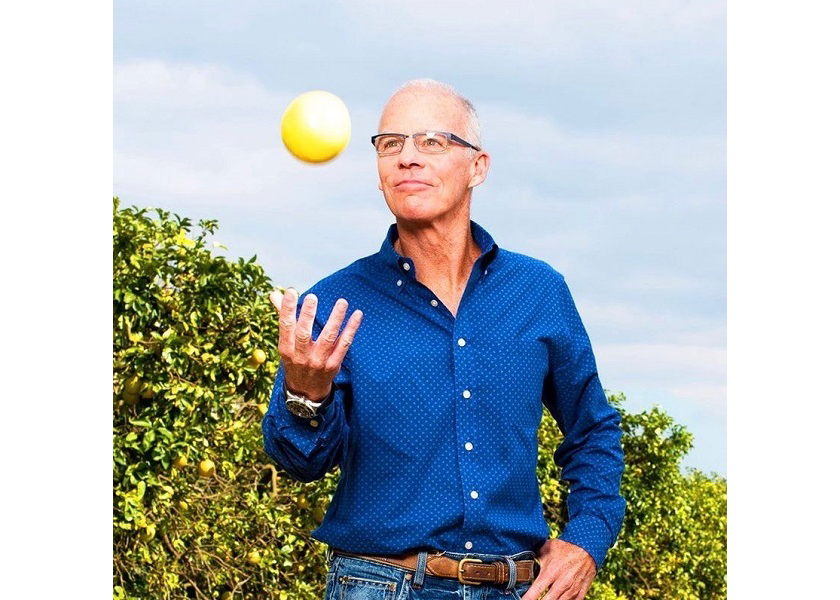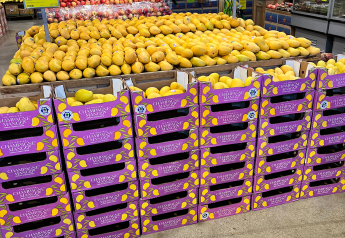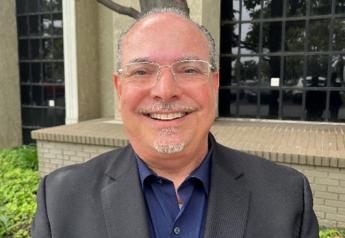Challenges breed toughness for Florida citrus leaders

The year 1981 was the the start of a long career for Dan Richey, president and chief executive officer of Vero Beach, Fla.-based citrus grower-shipper Riverfront Groves Inc.
Simple math means that 2022 represents Richey’s 42nd year in the industry.
Surviving the challenges that both nature and pests have thrown at the industry requires cultivating a certain attitude, Richey said.
The generation of citrus leaders that is now near retirement age in Florida has seen more than their share of troubles.
“I think it is what we choose to be; you can be 'woe is me,' choose to focus on the negative, or we can look for the positive and try to move forward and everything we do in this industry,” Richey said. “I try to look at everything that way.”
Whether that involves a produce industry issue, a Florida citrus concern or a trade issue, Richey said he likes to approach every issue with “high energy and optimism, without being Pollyanna.”
“And I think the model that I've used is one that I've taken from the Navy Seals, and that's adapt and overcome; you can't do everything the same way you once did,” Richey said. “The challenges in the 1980s, the freezes, were my indoctrination,” he said. “We had some horrific freezes, and the industry had to move from the northern tier of the citrus belt down to the southwest.”
The industry had to reorganize itself then.
“It boils down to having high-quality fruit, volume and operating efficiently,” he said. With the freezes, the 1980s introduced a roller coaster of a good year/bad year. That took a toll on the quality and the ability to be efficient, he added.
In the 1990s, the Florida citrus industry rolled into citrus canker, the state's first bite at a major invasive citrus disease. Since then, the industry has also experienced citrus blackspot and huanglongbing, aka HLB, or citrus greening.
“I think a lot of that was not of our own doing,” Richey said. “As global trade expanded, the world got smaller, and we opened the door to a lot of global trade, specifically from areas that had pests that we didn’t have. And as a government, we really didn't do a very good job protecting Florida agriculture.”
In some respects, Richey said, the Florida citrus industry was collateral damage from changes to U.S. trade policy and the expansion of global travel.
“I think Florida citrus is the poster child of what can happen to agriculture in this country if we don't implement the correct protective mechanisms to ensure that we have a viable, sustainable agricultural industry,” he said.
Richey was heavily involved in the fight against citrus canker and was an industry leader of a group that also included state and federal leaders who devised strategies to eradicate the disease.
Looking back now, Richey said, the introduction of the “1,900-foot rule" in the year 2000 was harmful to the industry. The rule eliminated any citrus tree within 1,900 feet of a “speck” of canker the size of a pencil point. The previous rule specified the destruction of trees within 250 feet of canker in the grove.
“In hindsight, that was the start of our own loss of acreage that was imposed upon ourselves by ourselves,” Richey said. “As you look back on that, and you see where we are today, that [rule] was probably a mistake.”
At the time, research by USDA scientists showed that, in wind-driving rain, the canker bacteria could spread 1,900 feet.
“I think the science was sound,” Richey said. “But we didn't acknowledge that canker was endemic until it was too late.”
HLB impact
Richey said HLB has had a much more devastating effect on Florida’s citrus industry than canker has.
“Canker was self-imposed, and when we stopped [trying to eradicate canker], we realized we could probably live with canker,” he said. “But HLB is a real challenge; it is the ultimate challenge we've faced.” In fact, Richey said, HLB may be the ultimate challenge faced in the history of the industry.
There is no known cure for HLB. “If you really step back and do a case study, there's not a whole lot of areas in the world, where HLB is endemic, that is a viable industry."
Although recent measures have helped Florida regain footing, the endemic nature of HLB and urban encroachment are continuing realities.
In contrast, California growers have a mountain range between the heavily populated urban areas and the growing areas to help protect citrus trees from HLB.
In addition, Mexican citrus growers have some geographic separation, and China’s citrus groves have natural predators to help keep the psyllids suppressed, Richey said.
A conversation between Richey and several Chinese growers years ago pointed to the fact that the industry there has relied on predators to help cushion the spread of HLB. In Florida, by contrast, there is no predator suppression of psyllids.
“They said to me, ‘For us, the psyllid marched across Asia, and the predators followed; in your case, psyllids carrying [HLB] came in on a container ship with no predators,” he said.
“If I had to look back and say, ‘What could we have done better on HLB?’ On that, we probably were a little bit slow to react, because we really didn't know what the animal was,” he said. “We were kind of paralyzed for a while and didn't take any action; suppression of the psyllid would have been a great opportunity that we may have missed if we got a little more aggressive there. But again, we don't have that separation. It came in on a vessel and worked its way through [groves], and before we knew it, it was everywhere.”
California authorities are doing suppression treatments in the urban areas to keep HLB contained, but Richey said Florida growers didn’t have the advantage of the geography that some of the other growing areas have, nor does Florida have the advantage of any natural predators.
Florida’s growing region just wasn’t big enough to run away from HLB.
“We can’t isolate like these other countries; we don't have the expanse of land that we can just pick up and move to an area, then start our own suppression to keep it out,” he said. “We just can’t keep it out.”
Canker was spread by hurricanes all over the state, and urban encroachment, illustrated by the fact that 1,000 people a day are moving to Florida, has made grove management and disease eradication more challenging.
“Urban encroachment, and then HLB, really put the exclamation point on our on our list of challenges,” Richey said.
Another arrow of outrageous fortune the industry has endured has been the medical community's caution to the public about drinking grapefruit juice in combination with statins, a drug for helping control blood pressure.
“That had a big impact,’ Richey said. “I was chairman of the commission when all that happened, and we did a second study we commissioned from Vanderbilt, which kind of trumped that whole idea that it was truly a problem.”
In any case, the medical community’s messaging against grapefruit hurt the industry.
“That was a problem because, obviously, it was targeted at those that were taking statins, and that was the group that was our target market,” he said. “It had a major impact on demand for grapefruit juice, and some carryover to dim fresh grapefruit demand."
King-sized
Florida’s grapefruit industry in the early 1990s produced 60 million boxes of grapefruit, of which about 5 million boxes were economically abandoned. That translated to about 50 million cartons of fresh shipments.
At the time, Florida exported about 12 million cartons to Japan and about 9 million to Europe. In addition, Richey said the domestic market was very vibrant.
“There weren't any imports to compete [with] and there wasn’t competition for the shelf space,” Richey said. There were no Cuties; none of those now-popular specialty citrus varieties were present in the winter months back then.
“We pretty much owned the winter months with the navel orange in California,” Richey said, with apples providing another constant presence.
Fast-forward, and the USDA reported that 2021 fresh shipments of Florida grapefruit tallied less than 4 million 40-pound cartons.
In contrast to 40 years ago, produce departments are now also receiving peaches, plums, cantaloupes and grapes during the winter from South America.
“We discovered that Chile is the California of South America, and they produce everything in our winter that California produces in the summer, and now it's here,” Richey said.
The future
As far as planning for the future, Richey said there are two parallel thoughts as to grapefruit output. One is the Citrus Under Protective Screens, or CUPS, method, which he said seems to be viable.
“And it's being really focused on grapefruit because grapefruit seems to do well in that environment,” he said, noting that Dundee Citrus is leading with that approach.
“They're the primary ones that are doing it; they have the most acreage dedicated to it,” he said. The system clearly does keep the psyllids off, and has the tree density of 300 trees to the acre, as opposed to about 150 trees on average for a typical grove.
Yields with the CUPS system could be 1,000 boxes to the acre, he said.
“The economics make sense if the fruit quality is such that it meets the same standards that the expectation of the consumer has, and an indoor and outdoor, or screenhouse and non-screenhouse, quality will be the same," he said. However, the system is expensive, so that will be a big barrier to entry.
“We’re staying outdoors and we're doing things in a different manner,” he said, noting the firm is utilizing a clay-based product the company sprays on its young trees every two weeks, with alternating colors of white and red.
The psyllid responds to the color green and can’t see red and white. “It won’t land on that tree, and it won’t infect it because it can’t see that color," he said, adding that the firm has enjoyed good success with that strategy.
Another strategy that the company is doing is testing multiple rootstocks and scion combinations. Star Ruby, a very vibrant grapefruit variety, has been a challenging variety to grow because it grows constantly and doesn’t go dormant as much as other varieties, which can leave it susceptible to freezes.
However, according to Richey, growers believe that, because star ruby is such a vigorous grower, it may be outpacing the greening disease that clogs the trees’ vascular systems.
“Our 40-plus-year-old trees that are Star Rubies are still producing 400 boxes to the acre; they haven't been adversely impacted,” said. “So, we're replanting some of our older groves. We're in the process of replanting 1,500 acres of grapefruit, primarily Star Rubies, on a different rootstock that we think is a good match.”
The aim is to plant a tree and get it to be 3 or 4 years old without being infected.
“There are some other opportunities coming down the pike, we believe, as these trees get older, keep them from infection,” he said. Richey added that the firm is also involved in strategic alliances with others, as well as long-term contracts on juice fruit that takes out the price component.
“We’re planting lemons, in a situation where we have a long-term contract with Peace River Citrus Products, which has a long-term contract with Coke,” he said. The Coca-Cola Co. wanted geographical diversity in its supply, and the company provided incentives to plant lemons under a long-term contract.
“If we can grow what we think we can grow, it makes sense economically,” Richey said. “Where we were 100% grapefruit, we’re diversifying into lemons, and then we continue that whole thought process with Peace River and Coke on oranges.
“So, we feel like those two varieties are doing better and we at least utilize them for our cash flow until grapefruit comes back,” he continued. “So, we are very aggressive, very strategic; we don’t have our heads in the sand and not looking at all the risk profile. We're trying to offset some of that risk profile with some strategic alliances and some long-term contracts, and all of the other things that we're learning day to day, and implementing them in an aggressive way.”
Richey said lemons and Star Ruby grapefruit appear to fare better against greening than some other citrus varieties.
“When you look at the common thread between Star Rubies and lemons, they're both very vigorous growers, they are constantly growing,” he said. “I just feel like, maybe that's a link to why they're handling citrus greening a little bit better. They are infected but they seem to live with it a little better.”
Hitting bottom
Richey said the Florida grapefruit industry may be at the delta, or low point, of its supply.
“We will come out of that, but we will never probably go back to 60 million boxes [of] grapefruit, nor may we never go back to 260 million boxes of oranges," Richey said.
But grapefruit is not going away.
“The industry is going to be different, we will be here, our supply will be lower, our costs are higher, therefore the price is going to be reflected in that,” he said. It will take time to get production and boxes per acre back to where they were, though.
“Grapefruit is not going away; that’s the clear message to the trade," Richey said. "We are not going away; we are going through a retooling of our industry. But we're not going away. We will be different, but we will be here.”
Fighting back
Richey said citrus varieties that are genetically modified organisms may be possibilities in the future.
Beyond all the needed regulatory approvals, finding consumer acceptance is important.
“It is tricky with the GMO piece,” he said.
The industry has seen some success with the application of bactericides, however.
“The question is, how can we more effectively get that bactericide into the tree and know that it can attack the bacteria,” he said.
The ability to inject the bactericide into the tree is a challenge, and researchers have looked at etching the leaves to have a better entry point for the bactericide.
“We're working on some things now that have some hope to keep trees at a low level of infection while they're young by using clay or tree bags, or CUPS,” he said, noting that these strategies will allow trees to sustain and produce commercially.
“There’s no silver bullet, but there is optimism there,” he said.
Crop outlook
For the 2022-2023 crop year, Richey said, older trees that have been infected with citrus greening are struggling. However, the younger citrus trees look good.
“I think we'll probably see a small reduction in volume on the grapefruit crop from this year to next year,” he said, noting that bloom was good but not fantastic.
Between Florida and Texas, which is coming off a freeze year, Richey said supply should be enough to meet consumer demand. The domestic industry is impatient for the USDA to stop allowing Mexican grapefruit into the U.S. that doesn’t meet the juice standard required in Florida, however.
“We are working to try to remedy that, but we haven’t made a lot of headway,” he said.
On his future
Richey, now 64, said he isn’t looking to retire anytime soon.
“I have no intentions of retiring,” he said. “What I want to see is that we are in the process of planting 1,500 acres and it’s going to be three to four years before we get to off [those trees] and start to curve volume upwards."
Riverfront Groves has a strategic alliance with Dundee Citrus, the company doing the majority of growing under screens.
“Joining together, the two of us could have, by far, the large majority of grapefruit and Florida to market,” Richey said. “My role will certainly be to rebuild rebuild the export markets as we get that back.”
The challenge that is the Florida citrus industry is one that Richey said he thoroughly enjoys.
“The thing that keeps me going is the dedication of our growers, their beliefs and their work, and trying to grow this,” he said. “It’s my job to make sure I don't let them down, and then we get this fruit monetized to the point that they can stay in business.”
Richey said he wants to see young plantings of citrus start to bear fruit. “That's a 10-year process, so I can't see slowing down.”







